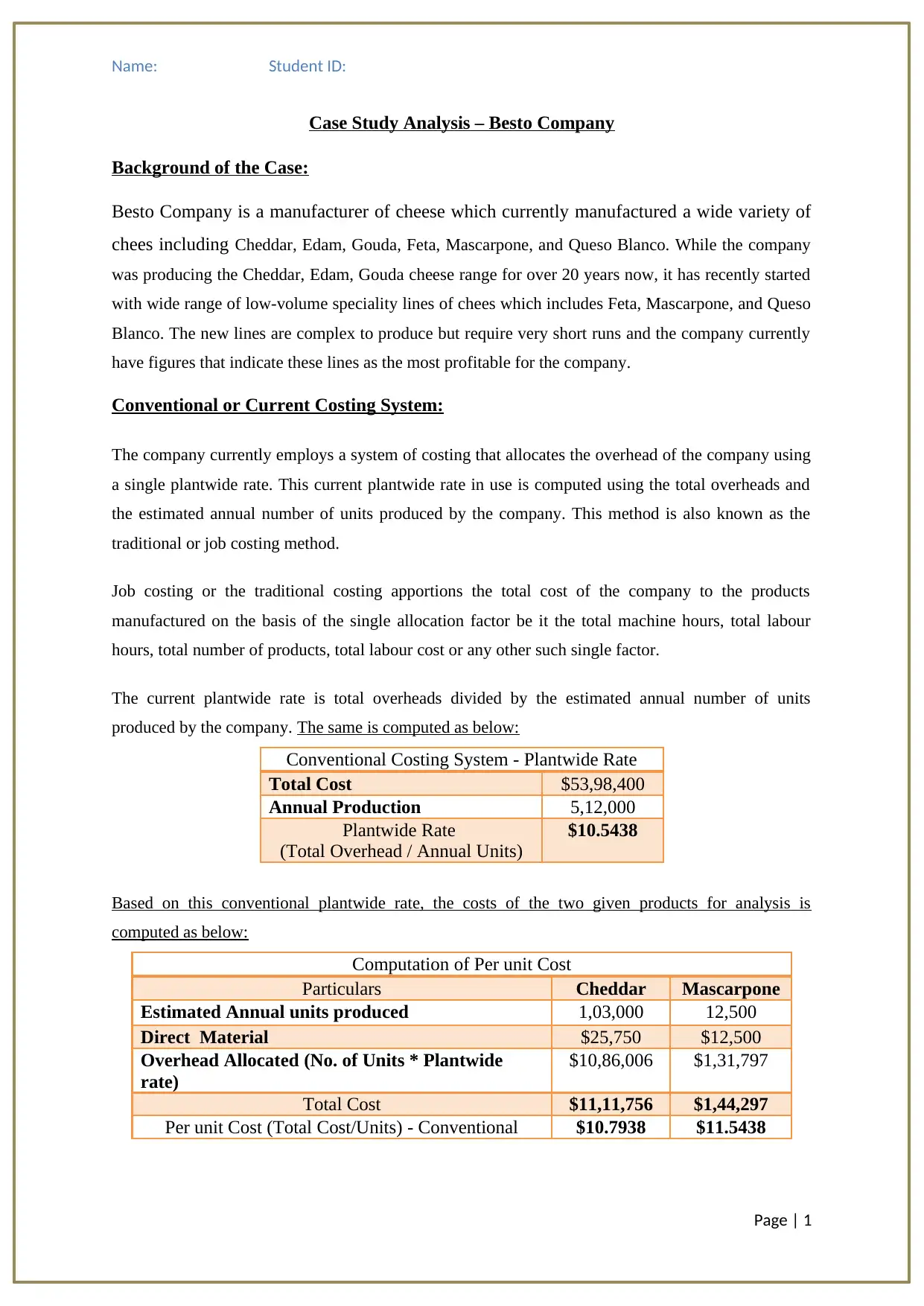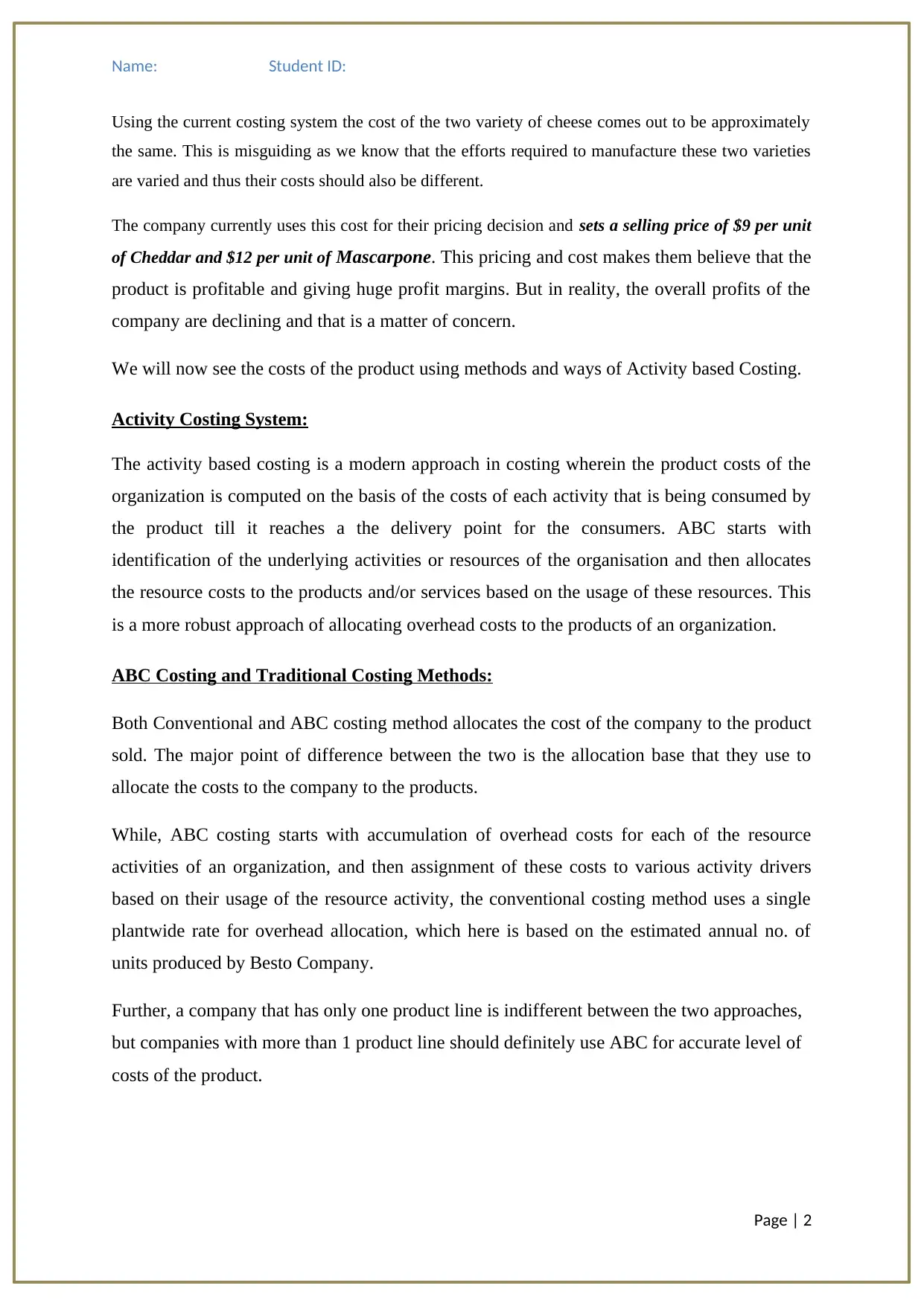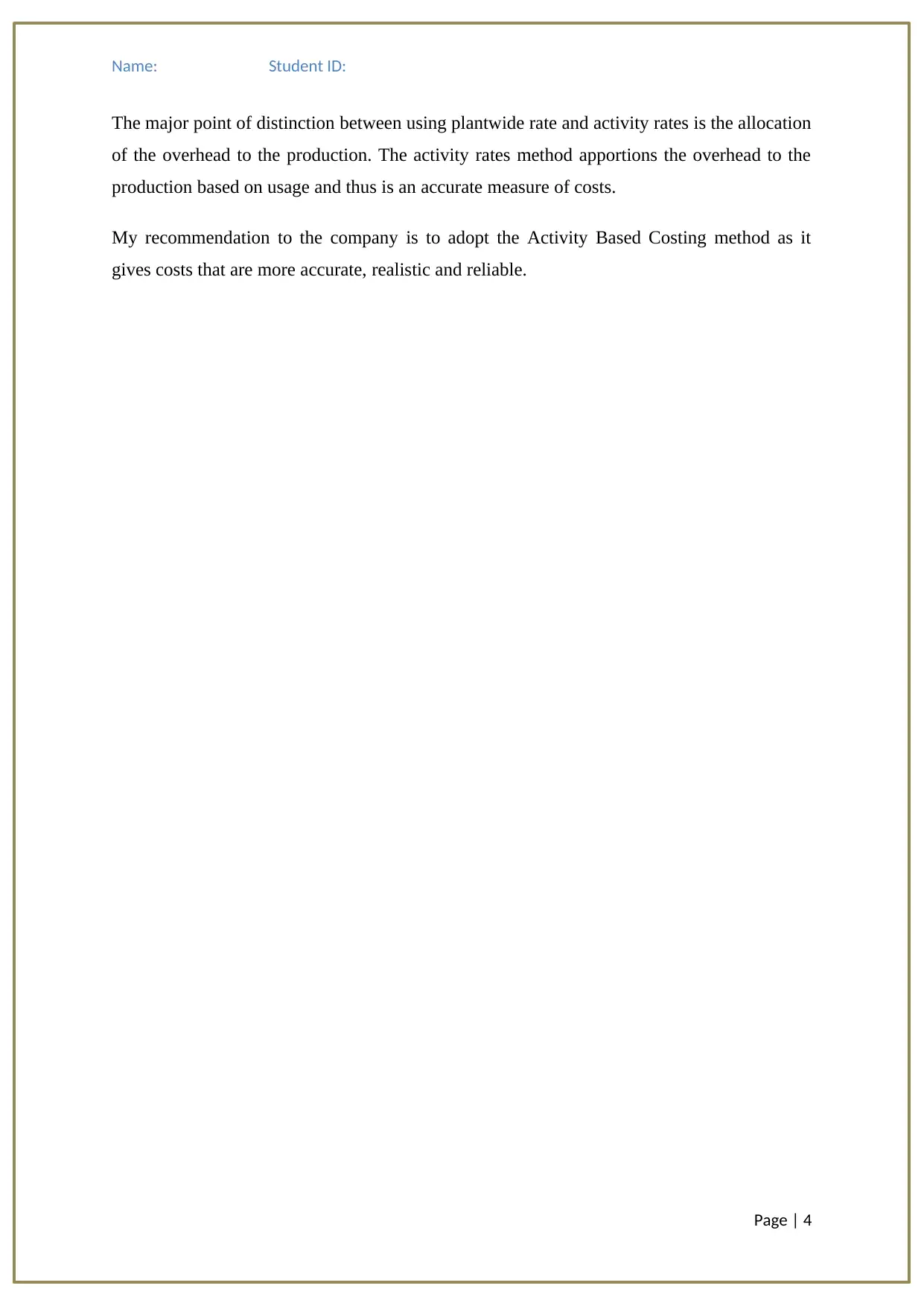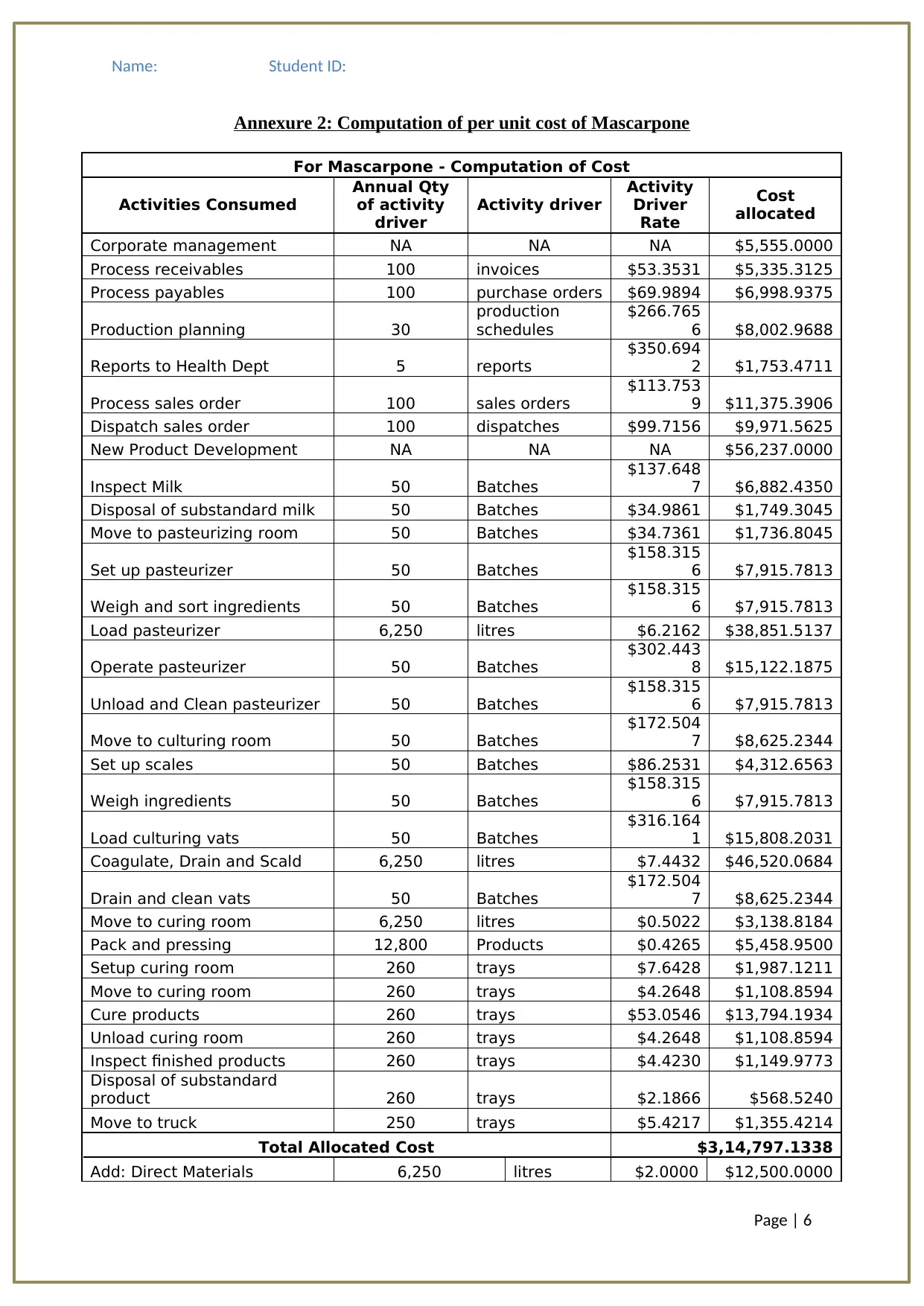Case Study Analysis – Besto Company
VerifiedAdded on 2022/11/25
|6
|1868
|199
AI Summary
This case study analysis examines the use of activity based costing in Besto Company, a cheese manufacturer. It compares the conventional costing system with the activity based costing method and recommends the adoption of activity based costing for more accurate cost allocation and pricing decisions.
Contribute Materials
Your contribution can guide someone’s learning journey. Share your
documents today.

Name: Student ID:
Case Study Analysis – Besto Company
Background of the Case:
Besto Company is a manufacturer of cheese which currently manufactured a wide variety of
chees including Cheddar, Edam, Gouda, Feta, Mascarpone, and Queso Blanco. While the company
was producing the Cheddar, Edam, Gouda cheese range for over 20 years now, it has recently started
with wide range of low-volume speciality lines of chees which includes Feta, Mascarpone, and Queso
Blanco. The new lines are complex to produce but require very short runs and the company currently
have figures that indicate these lines as the most profitable for the company.
Conventional or Current Costing System:
The company currently employs a system of costing that allocates the overhead of the company using
a single plantwide rate. This current plantwide rate in use is computed using the total overheads and
the estimated annual number of units produced by the company. This method is also known as the
traditional or job costing method.
Job costing or the traditional costing apportions the total cost of the company to the products
manufactured on the basis of the single allocation factor be it the total machine hours, total labour
hours, total number of products, total labour cost or any other such single factor.
The current plantwide rate is total overheads divided by the estimated annual number of units
produced by the company. The same is computed as below:
Conventional Costing System - Plantwide Rate
Total Cost $53,98,400
Annual Production 5,12,000
Plantwide Rate
(Total Overhead / Annual Units)
$10.5438
Based on this conventional plantwide rate, the costs of the two given products for analysis is
computed as below:
Computation of Per unit Cost
Particulars Cheddar Mascarpone
Estimated Annual units produced 1,03,000 12,500
Direct Material $25,750 $12,500
Overhead Allocated (No. of Units * Plantwide
rate)
$10,86,006 $1,31,797
Total Cost $11,11,756 $1,44,297
Per unit Cost (Total Cost/Units) - Conventional $10.7938 $11.5438
Page | 1
Case Study Analysis – Besto Company
Background of the Case:
Besto Company is a manufacturer of cheese which currently manufactured a wide variety of
chees including Cheddar, Edam, Gouda, Feta, Mascarpone, and Queso Blanco. While the company
was producing the Cheddar, Edam, Gouda cheese range for over 20 years now, it has recently started
with wide range of low-volume speciality lines of chees which includes Feta, Mascarpone, and Queso
Blanco. The new lines are complex to produce but require very short runs and the company currently
have figures that indicate these lines as the most profitable for the company.
Conventional or Current Costing System:
The company currently employs a system of costing that allocates the overhead of the company using
a single plantwide rate. This current plantwide rate in use is computed using the total overheads and
the estimated annual number of units produced by the company. This method is also known as the
traditional or job costing method.
Job costing or the traditional costing apportions the total cost of the company to the products
manufactured on the basis of the single allocation factor be it the total machine hours, total labour
hours, total number of products, total labour cost or any other such single factor.
The current plantwide rate is total overheads divided by the estimated annual number of units
produced by the company. The same is computed as below:
Conventional Costing System - Plantwide Rate
Total Cost $53,98,400
Annual Production 5,12,000
Plantwide Rate
(Total Overhead / Annual Units)
$10.5438
Based on this conventional plantwide rate, the costs of the two given products for analysis is
computed as below:
Computation of Per unit Cost
Particulars Cheddar Mascarpone
Estimated Annual units produced 1,03,000 12,500
Direct Material $25,750 $12,500
Overhead Allocated (No. of Units * Plantwide
rate)
$10,86,006 $1,31,797
Total Cost $11,11,756 $1,44,297
Per unit Cost (Total Cost/Units) - Conventional $10.7938 $11.5438
Page | 1
Secure Best Marks with AI Grader
Need help grading? Try our AI Grader for instant feedback on your assignments.

Name: Student ID:
Using the current costing system the cost of the two variety of cheese comes out to be approximately
the same. This is misguiding as we know that the efforts required to manufacture these two varieties
are varied and thus their costs should also be different.
The company currently uses this cost for their pricing decision and sets a selling price of $9 per unit
of Cheddar and $12 per unit of Mascarpone. This pricing and cost makes them believe that the
product is profitable and giving huge profit margins. But in reality, the overall profits of the
company are declining and that is a matter of concern.
We will now see the costs of the product using methods and ways of Activity based Costing.
Activity Costing System:
The activity based costing is a modern approach in costing wherein the product costs of the
organization is computed on the basis of the costs of each activity that is being consumed by
the product till it reaches a the delivery point for the consumers. ABC starts with
identification of the underlying activities or resources of the organisation and then allocates
the resource costs to the products and/or services based on the usage of these resources. This
is a more robust approach of allocating overhead costs to the products of an organization.
ABC Costing and Traditional Costing Methods:
Both Conventional and ABC costing method allocates the cost of the company to the product
sold. The major point of difference between the two is the allocation base that they use to
allocate the costs to the company to the products.
While, ABC costing starts with accumulation of overhead costs for each of the resource
activities of an organization, and then assignment of these costs to various activity drivers
based on their usage of the resource activity, the conventional costing method uses a single
plantwide rate for overhead allocation, which here is based on the estimated annual no. of
units produced by Besto Company.
Further, a company that has only one product line is indifferent between the two approaches,
but companies with more than 1 product line should definitely use ABC for accurate level of
costs of the product.
Page | 2
Using the current costing system the cost of the two variety of cheese comes out to be approximately
the same. This is misguiding as we know that the efforts required to manufacture these two varieties
are varied and thus their costs should also be different.
The company currently uses this cost for their pricing decision and sets a selling price of $9 per unit
of Cheddar and $12 per unit of Mascarpone. This pricing and cost makes them believe that the
product is profitable and giving huge profit margins. But in reality, the overall profits of the
company are declining and that is a matter of concern.
We will now see the costs of the product using methods and ways of Activity based Costing.
Activity Costing System:
The activity based costing is a modern approach in costing wherein the product costs of the
organization is computed on the basis of the costs of each activity that is being consumed by
the product till it reaches a the delivery point for the consumers. ABC starts with
identification of the underlying activities or resources of the organisation and then allocates
the resource costs to the products and/or services based on the usage of these resources. This
is a more robust approach of allocating overhead costs to the products of an organization.
ABC Costing and Traditional Costing Methods:
Both Conventional and ABC costing method allocates the cost of the company to the product
sold. The major point of difference between the two is the allocation base that they use to
allocate the costs to the company to the products.
While, ABC costing starts with accumulation of overhead costs for each of the resource
activities of an organization, and then assignment of these costs to various activity drivers
based on their usage of the resource activity, the conventional costing method uses a single
plantwide rate for overhead allocation, which here is based on the estimated annual no. of
units produced by Besto Company.
Further, a company that has only one product line is indifferent between the two approaches,
but companies with more than 1 product line should definitely use ABC for accurate level of
costs of the product.
Page | 2

Name: Student ID:
Benefits, Costs and Limitation of ABC Method:
ABC do not use a flat rate to allocate the overhead and instead use usage based
approach to compute the accurate allocation based on usage of activity. Thus, it is
more accurate evaluation of product cost.
This accurate cost is pivotal to any organization for their decision making on product
pricing and gives them an edge while negotiating with the clients.
The accurate costs help the company in better decision making by controlling and
monitoring costs.
The cost of implementing the ABC is substantial but the benefits ensure that the NPV of
implementing ABC is positive. The limitation of the approach is that the process takes
substantial time and cost at the initial phase.
ABC and Traditional Method for Besto Company
In the given case, ABC or the activity based costing provides more accurate data on the cost
incurred to produce the two varieties of cheese. The comparison of costs under both these
methods is as below:
Particulars Cheddar Mascarpone
Per unit Cost - Conventional $10.7938 $11.5438
Per unit Cost - ABC $10.1037 $26.1838
Selling Price per unit $9.0000 $12.0000
Profit per unit - ABC -$1.1037 -$14.1838
Profit per unit - Conventional -$1.7938 $0.4563
(Please refer Annexure 1 and 2 for per unit costs of the product under ABC)
We see that the ABC has given a result which is different from the conventional method that
the company has been following. The conventional method estimated that the cost to
manufacture one unit of Mascarpone is $11.5438 whereas ABC revealed the true cost as
$26.1838. Further for cheddar, the conventional method estimated a higher amount. This is
indicative of the fact that under conventional method more of overheads were allocated to the
cheddar as the no. of units produced are more which not the true representation of costs is.
This leads to inaccurate pricing of the products.
Recommendation for Besto Company
Page | 3
Benefits, Costs and Limitation of ABC Method:
ABC do not use a flat rate to allocate the overhead and instead use usage based
approach to compute the accurate allocation based on usage of activity. Thus, it is
more accurate evaluation of product cost.
This accurate cost is pivotal to any organization for their decision making on product
pricing and gives them an edge while negotiating with the clients.
The accurate costs help the company in better decision making by controlling and
monitoring costs.
The cost of implementing the ABC is substantial but the benefits ensure that the NPV of
implementing ABC is positive. The limitation of the approach is that the process takes
substantial time and cost at the initial phase.
ABC and Traditional Method for Besto Company
In the given case, ABC or the activity based costing provides more accurate data on the cost
incurred to produce the two varieties of cheese. The comparison of costs under both these
methods is as below:
Particulars Cheddar Mascarpone
Per unit Cost - Conventional $10.7938 $11.5438
Per unit Cost - ABC $10.1037 $26.1838
Selling Price per unit $9.0000 $12.0000
Profit per unit - ABC -$1.1037 -$14.1838
Profit per unit - Conventional -$1.7938 $0.4563
(Please refer Annexure 1 and 2 for per unit costs of the product under ABC)
We see that the ABC has given a result which is different from the conventional method that
the company has been following. The conventional method estimated that the cost to
manufacture one unit of Mascarpone is $11.5438 whereas ABC revealed the true cost as
$26.1838. Further for cheddar, the conventional method estimated a higher amount. This is
indicative of the fact that under conventional method more of overheads were allocated to the
cheddar as the no. of units produced are more which not the true representation of costs is.
This leads to inaccurate pricing of the products.
Recommendation for Besto Company
Page | 3

Name: Student ID:
The major point of distinction between using plantwide rate and activity rates is the allocation
of the overhead to the production. The activity rates method apportions the overhead to the
production based on usage and thus is an accurate measure of costs.
My recommendation to the company is to adopt the Activity Based Costing method as it
gives costs that are more accurate, realistic and reliable.
Page | 4
The major point of distinction between using plantwide rate and activity rates is the allocation
of the overhead to the production. The activity rates method apportions the overhead to the
production based on usage and thus is an accurate measure of costs.
My recommendation to the company is to adopt the Activity Based Costing method as it
gives costs that are more accurate, realistic and reliable.
Page | 4
Secure Best Marks with AI Grader
Need help grading? Try our AI Grader for instant feedback on your assignments.

Name: Student ID:
Annexure 1: Computation of per unit cost of Cheddar
For Cheddar - Computation of Cost
Activities Consumed Annual Qty of
activity driver Activity driver Activity
Driver Rate Cost allocated
Corporate management NA NA NA $45,771.0000
Process receivables 300 invoices $53.3531 $16,005.9375
Process payables 100 purchase orders $69.9894 $6,998.9375
Production planning 180
production
schedules $266.7656 $48,017.8125
Reports to Health Dept 18 reports $350.6942 $6,312.4961
Process sales order 320 sales orders $113.7539 $36,401.2500
Dispatch sales order 300 dispatches $99.7156 $29,914.6875
New Product Development NA NA NA $0.0000
Inspect Milk 180 Batches $137.6487 $24,776.7660
Disposal of substandard milk 180 Batches $34.9861 $6,297.4961
Move to pasteurizing room 180 Batches $34.7361 $6,252.4961
Set up pasteurizer 180 Batches $158.3156 $28,496.8125
Weigh and sort ingredients 180 Batches $158.3156 $28,496.8125
Load pasteurizer 25,750 litres $6.2162 $1,60,068.2363
Operate pasteurizer 180 Batches $302.4438 $54,439.8750
Unload and Clean pasteurizer 180 Batches $158.3156 $28,496.8125
Move to culturing room 180 Batches $172.5047 $31,050.8438
Set up scales 180 Batches $86.2531 $15,525.5625
Weigh ingredients 180 Batches $158.3156 $28,496.8125
Load culturing vats 180 Batches $316.1641 $56,909.5313
Coagulate, Drain and Scald 25,750 litres $7.4432 $1,91,662.6816
Drain and clean vats 180 Batches $172.5047 $31,050.8438
Move to curing room 25,750 litres $0.5022 $12,931.9316
Pack and pressing 1,02,400 Products $0.4265 $43,671.6000
Setup curing room 1,030 trays $7.6428 $7,872.0566
Move to curing room 1,030 trays $4.2648 $4,392.7891
Cure products 1,030 trays $53.0546 $54,646.2275
Unload curing room 1,030 trays $4.2648 $4,392.7891
Inspect finished products 0 trays $4.4230 $0.0000
Disposal of substandard
product 0 trays $2.1866 $0.0000
Move to truck 1,030 trays $5.4217 $5,584.3361
Total Allocated Cost $10,14,935.4334
Add: Direct Materials 25,750 litres $1.0000 $25,750.0000
Total Cost $10,40,685.4334
Annual Volume 1,03,000
Per Unit Cost of Cheddar (Total Cost/Annual Volume) $10.1037
Page | 5
Annexure 1: Computation of per unit cost of Cheddar
For Cheddar - Computation of Cost
Activities Consumed Annual Qty of
activity driver Activity driver Activity
Driver Rate Cost allocated
Corporate management NA NA NA $45,771.0000
Process receivables 300 invoices $53.3531 $16,005.9375
Process payables 100 purchase orders $69.9894 $6,998.9375
Production planning 180
production
schedules $266.7656 $48,017.8125
Reports to Health Dept 18 reports $350.6942 $6,312.4961
Process sales order 320 sales orders $113.7539 $36,401.2500
Dispatch sales order 300 dispatches $99.7156 $29,914.6875
New Product Development NA NA NA $0.0000
Inspect Milk 180 Batches $137.6487 $24,776.7660
Disposal of substandard milk 180 Batches $34.9861 $6,297.4961
Move to pasteurizing room 180 Batches $34.7361 $6,252.4961
Set up pasteurizer 180 Batches $158.3156 $28,496.8125
Weigh and sort ingredients 180 Batches $158.3156 $28,496.8125
Load pasteurizer 25,750 litres $6.2162 $1,60,068.2363
Operate pasteurizer 180 Batches $302.4438 $54,439.8750
Unload and Clean pasteurizer 180 Batches $158.3156 $28,496.8125
Move to culturing room 180 Batches $172.5047 $31,050.8438
Set up scales 180 Batches $86.2531 $15,525.5625
Weigh ingredients 180 Batches $158.3156 $28,496.8125
Load culturing vats 180 Batches $316.1641 $56,909.5313
Coagulate, Drain and Scald 25,750 litres $7.4432 $1,91,662.6816
Drain and clean vats 180 Batches $172.5047 $31,050.8438
Move to curing room 25,750 litres $0.5022 $12,931.9316
Pack and pressing 1,02,400 Products $0.4265 $43,671.6000
Setup curing room 1,030 trays $7.6428 $7,872.0566
Move to curing room 1,030 trays $4.2648 $4,392.7891
Cure products 1,030 trays $53.0546 $54,646.2275
Unload curing room 1,030 trays $4.2648 $4,392.7891
Inspect finished products 0 trays $4.4230 $0.0000
Disposal of substandard
product 0 trays $2.1866 $0.0000
Move to truck 1,030 trays $5.4217 $5,584.3361
Total Allocated Cost $10,14,935.4334
Add: Direct Materials 25,750 litres $1.0000 $25,750.0000
Total Cost $10,40,685.4334
Annual Volume 1,03,000
Per Unit Cost of Cheddar (Total Cost/Annual Volume) $10.1037
Page | 5

Name: Student ID:
Annexure 2: Computation of per unit cost of Mascarpone
For Mascarpone - Computation of Cost
Activities Consumed
Annual Qty
of activity
driver
Activity driver
Activity
Driver
Rate
Cost
allocated
Corporate management NA NA NA $5,555.0000
Process receivables 100 invoices $53.3531 $5,335.3125
Process payables 100 purchase orders $69.9894 $6,998.9375
Production planning 30
production
schedules
$266.765
6 $8,002.9688
Reports to Health Dept 5 reports
$350.694
2 $1,753.4711
Process sales order 100 sales orders
$113.753
9 $11,375.3906
Dispatch sales order 100 dispatches $99.7156 $9,971.5625
New Product Development NA NA NA $56,237.0000
Inspect Milk 50 Batches
$137.648
7 $6,882.4350
Disposal of substandard milk 50 Batches $34.9861 $1,749.3045
Move to pasteurizing room 50 Batches $34.7361 $1,736.8045
Set up pasteurizer 50 Batches
$158.315
6 $7,915.7813
Weigh and sort ingredients 50 Batches
$158.315
6 $7,915.7813
Load pasteurizer 6,250 litres $6.2162 $38,851.5137
Operate pasteurizer 50 Batches
$302.443
8 $15,122.1875
Unload and Clean pasteurizer 50 Batches
$158.315
6 $7,915.7813
Move to culturing room 50 Batches
$172.504
7 $8,625.2344
Set up scales 50 Batches $86.2531 $4,312.6563
Weigh ingredients 50 Batches
$158.315
6 $7,915.7813
Load culturing vats 50 Batches
$316.164
1 $15,808.2031
Coagulate, Drain and Scald 6,250 litres $7.4432 $46,520.0684
Drain and clean vats 50 Batches
$172.504
7 $8,625.2344
Move to curing room 6,250 litres $0.5022 $3,138.8184
Pack and pressing 12,800 Products $0.4265 $5,458.9500
Setup curing room 260 trays $7.6428 $1,987.1211
Move to curing room 260 trays $4.2648 $1,108.8594
Cure products 260 trays $53.0546 $13,794.1934
Unload curing room 260 trays $4.2648 $1,108.8594
Inspect finished products 260 trays $4.4230 $1,149.9773
Disposal of substandard
product 260 trays $2.1866 $568.5240
Move to truck 250 trays $5.4217 $1,355.4214
Total Allocated Cost $3,14,797.1338
Add: Direct Materials 6,250 litres $2.0000 $12,500.0000
Page | 6
Annexure 2: Computation of per unit cost of Mascarpone
For Mascarpone - Computation of Cost
Activities Consumed
Annual Qty
of activity
driver
Activity driver
Activity
Driver
Rate
Cost
allocated
Corporate management NA NA NA $5,555.0000
Process receivables 100 invoices $53.3531 $5,335.3125
Process payables 100 purchase orders $69.9894 $6,998.9375
Production planning 30
production
schedules
$266.765
6 $8,002.9688
Reports to Health Dept 5 reports
$350.694
2 $1,753.4711
Process sales order 100 sales orders
$113.753
9 $11,375.3906
Dispatch sales order 100 dispatches $99.7156 $9,971.5625
New Product Development NA NA NA $56,237.0000
Inspect Milk 50 Batches
$137.648
7 $6,882.4350
Disposal of substandard milk 50 Batches $34.9861 $1,749.3045
Move to pasteurizing room 50 Batches $34.7361 $1,736.8045
Set up pasteurizer 50 Batches
$158.315
6 $7,915.7813
Weigh and sort ingredients 50 Batches
$158.315
6 $7,915.7813
Load pasteurizer 6,250 litres $6.2162 $38,851.5137
Operate pasteurizer 50 Batches
$302.443
8 $15,122.1875
Unload and Clean pasteurizer 50 Batches
$158.315
6 $7,915.7813
Move to culturing room 50 Batches
$172.504
7 $8,625.2344
Set up scales 50 Batches $86.2531 $4,312.6563
Weigh ingredients 50 Batches
$158.315
6 $7,915.7813
Load culturing vats 50 Batches
$316.164
1 $15,808.2031
Coagulate, Drain and Scald 6,250 litres $7.4432 $46,520.0684
Drain and clean vats 50 Batches
$172.504
7 $8,625.2344
Move to curing room 6,250 litres $0.5022 $3,138.8184
Pack and pressing 12,800 Products $0.4265 $5,458.9500
Setup curing room 260 trays $7.6428 $1,987.1211
Move to curing room 260 trays $4.2648 $1,108.8594
Cure products 260 trays $53.0546 $13,794.1934
Unload curing room 260 trays $4.2648 $1,108.8594
Inspect finished products 260 trays $4.4230 $1,149.9773
Disposal of substandard
product 260 trays $2.1866 $568.5240
Move to truck 250 trays $5.4217 $1,355.4214
Total Allocated Cost $3,14,797.1338
Add: Direct Materials 6,250 litres $2.0000 $12,500.0000
Page | 6
1 out of 6
Related Documents
Your All-in-One AI-Powered Toolkit for Academic Success.
+13062052269
info@desklib.com
Available 24*7 on WhatsApp / Email
![[object Object]](/_next/static/media/star-bottom.7253800d.svg)
Unlock your academic potential
© 2024 | Zucol Services PVT LTD | All rights reserved.





